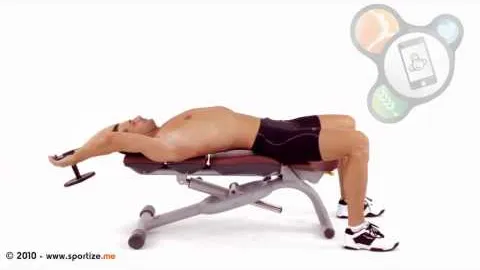
Are you looking to build a strong and well-defined upper body? Incorporating the dumbbell pullover on a flat bench exercise into your fitness routine can help you achieve just that. This compound exercise primarily targets your upper back, chest, and shoulders, while engaging your triceps and core muscles as well. In this comprehensive guide, we will dive deep into the technique, benefits, variations, and precautions associated with the dumbbell pullover on a flat bench exercise.
Set-Up: Begin by selecting an appropriate dumbbell weight and a flat bench. Sit on the bench with your feet firmly planted on the floor, shoulder-width apart. Ensure that your back is fully supported by the bench throughout the exercise.
Grip: Grab one dumbbell with an overhand grip, keeping your palms facing upwards. Position your hands so that they are slightly wider than shoulder-width apart.
Starting Position: Lie down on the bench, ensuring that the back of your head is resting comfortably. Hold the dumbbell directly above your chest, with your arms extended and slightly bent.
Movement: Begin the exercise by slowly lowering the dumbbell in an arc motion behind your head, while maintaining a slight bend in your elbows. Focus on engaging your back muscles to control the descent of the weight.
Stretch: When the dumbbell reaches a position parallel to the bench surface, pause for a moment to feel the stretch in your chest muscles.
Return: Exhale and engage your chest muscles as you reverse the motion, bringing the dumbbell back to the starting position. Ensure that your back is fully supported by the bench throughout the entire range of motion.
Repeat: Perform the desired number of repetitions, maintaining control and stability throughout the exercise.
Incorporating dumbbell pullovers on a flat bench into your fitness routine offers numerous benefits:
Upper Body Strength: The dumbbell pullover targets multiple muscle groups in your upper body, including the latissimus dorsi (lats), pectoralis major (pecs), deltoids, and triceps. As a result, it helps develop overall upper body strength and improves muscular endurance.
Chest Expansion: The stretching motion during the exercise helps expand the chest muscles, enhancing flexibility and range of motion.
Posture Correction: By engaging the muscles in your upper back and shoulders, the dumbbell pullover exercise promotes better posture and spinal alignment. This, in turn, can alleviate muscle imbalances and reduce the risk of back pain.
Open Shoulder Girdle: The motion of extending your arms behind your head stretches the anterior deltoids and pectoral muscles, which are often tight due to daily activities and sedentary lifestyles. Opening up the shoulder girdle can improve shoulder mobility and prevent shoulder impingement.
Core Engagement: To maintain stability during the exercise, your core muscles need to remain engaged. This helps strengthen your core and improves overall stability in functional movements.
To add variety to your workout routine, you can try these variations of the dumbbell pullover on a flat bench exercise:
Decline Dumbbell Pullover: Performing the dumbbell pullover on a decline bench helps target the lower portion of your chest, stimulating different muscle fibers and promoting complete chest development.
Bosu Ball Dumbbell Pullover: By performing the exercise on a Bosu ball, you challenge your core stability even further, as your body works to maintain balance on an unstable surface.
Dumbbell Pullover with Leg Lift: By incorporating a leg lift into the exercise, you engage your abdominal muscles to a greater extent, promoting core strength and stability.
While the dumbbell pullover on a flat bench exercise is generally safe, it's important to keep the following precautions in mind:
Start Light: Begin with lighter dumbbells to master the exercise technique before gradually increasing the weight. This will help prevent strain or injury.
Maintain Control: Focus on maintaining control throughout the exercise to avoid swinging or excessive momentum. This will ensure that the targeted muscles are effectively engaged and reduce the risk of joint or muscle strain.
Breathing Technique: Remember to breathe properly during the exercise. Inhale as you lower the dumbbell, and exhale as you bring it back to the starting position.
Avoid Overhead Extension: Do not extend your arms behind your head if you have any pre-existing shoulder or neck issues. If you experience discomfort or pain in these areas, consult a fitness professional or healthcare provider for guidance.
By following the proper technique, feeling the targeted muscles working, and gradually increasing the challenge, you can make the dumbbell pullover on a flat bench exercise a valuable addition to your upper body training routine.
Remember, consistency and progressive overload are key when seeking desired results. Always listen to your body, give yourself ample rest between sessions, and consult a fitness professional if you have any concerns or questions.
If you're looking for a gym, fitness club or yoga studio, you've come to the right place.
You can find information about gyms in your area. Browse catalog of gyms and find gyms with classes which are you looking for.
On gym page you can find simple information like address, phone or website. You can find list of available classes. You can check availability of personal training or small group classes. On place page you can also see information about open hours.
You can find gyms near you with amenities, courts, studios and equipments.
Use our map to find gym at your city or district.
In Gym Navigator you can find list of exercises with movies for many body parts.
You can browse exercises catalog and find exercises the best of you.
You can also find exercises grouped into workout plans, which you can use to improve you body. Each routine show you exercises one by one and give you possibility to count you progress and count down rest time.